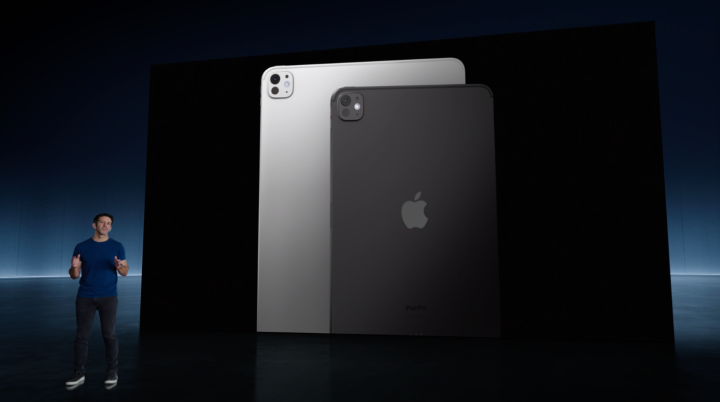
Earlier this year, I bought a new MacBook Air. It was the entry-level 13-inch trim with an eight-core graphics engine. If my budget allowed, I would’ve loved to go with the higher-end M3 version with a 10-core GPU inside.
Spending a few hundred dollars for the higher RAM and storage configuration automatically gets you the more powerful M3 variant. Conversely, you can’t just pay more for an M3 version with a beefier GPU. If you want the best performance possible, you have to pay for the higher storage/RAM models. It’s an infuriating and darn expensive situation, but that’s how Apple rolls.
Unfortunately, that stipulation is now a reality for the iPad Pro in 2024. Apple didn’t detail the caveat during its fancy presentation, but the specifications sheet offers a look at the unsavory bargain that will greet buyers a week from now.
There’s more to the M4 than you think

With the iPad Pro, Apple is switching things around, but the overarching theme is still the same. For the first time, the M-series silicon inside an iPad Pro will be available in two variants. The entry-point version comes with nine CPU cores, while the top-end trim offers 10 CPU cores.
The numerical difference is small, but do keep in mind that we’re talking about one less performance core, and not an efficiency core. A performance core does the heavy lifting for demanding tasks, and the difference it makes would definitely reflect in creative tasks.
You would ideally want the M4 iPad Pro with the 10-core configuration, but you’ll have to spend a lot more to do so. There doesn’t seem to be a middle ground here because everything is tied to the RAM and storage situation. Only the 1TB and 2TB storage models (which also have 16GB of

Imagine spending $1,199 on a tablet only to get 8GB of RAM and not the best processor available. And this is just the 11-inch version we’re talking about here. If your creative work requires a bigger screen, even $1,499 will keep you limited to 8GB of
To get the most out of the M4 silicon, the minimum tariff is 1TB of storage. That means you need to part ways with at least $1,599 for the 11-inch iPad Pro (1TB) to get the 10-core M4 silicon and 16GB of RAM. For the 13-inch model, the minimum ask soars to $1,899 for the same perk.
Extra costs keep adding up

I’ve been using an iPad Pro with an M1 chip for a healthy few years, and I still can’t figure out how to regularly push the machine to its full potential. That’s a great value for a thousand dollars, which isn’t much in an age when flagship phones cost more than that. In hindsight, it’s a pleasant assurance that the slate will continue to work just fine in the coming years.
That’s the kind of commitment I want from a machine I spent over a grand on. If I were to pick up the M4 iPad Pro with a keyboard bundle, my bill would touch $1,500, but I still won’t be getting the best M4 processor Apple has to offer. And that is before considering the extra cost for cellular connectivity.
That’s an outrageous amount of money to spend on a tablet. I am not making any Mac comparisons here and how a MacBook Air would offer a fantastic value for that price. But this is a tablet running iPadOS, which is incredibly short on the same kind of Pro apps that a full-fledged workhorse needs.
Yes, Final Cut Pro, Procreate, Logic Pro, and DaVinci Resolve are available on the iPad Pro. But once again, they are not full-fledged desktop alternatives. Moreover, apps of such caliber are far too few to really lift iPadOS. If you are incredibly lucky to land yourself a job where you don’t need Windows or macOS at all, good luck to you.

But even for those lucky few, getting the most out of the M4 iPad Pro is a pricey endeavor. For someone who works on the go, cellular connectivity is nearly indispensable. Apple would have you pay up to $200(!) for getting a cellular variant of the 2024 iPad Pro.
But whether Apple genuinely thinks of the iPad Pro as a laptop replacement, you can not truly use the aforementioned “pro” apps without a keyboard. I’m not sure I can use DaVinci Resolve or Final Cut Pro without any keyboard shortcuts and relying solely on touch controls for video editing. If you pair the iPad Pro with the new Magic Keyboard (which you should), you’re looking at another $349.
This isn’t a good look

The minimum price this year for the iPad Pro is $999, up from the $799 base price that the M2 iPad Pro commanded. Yes, a faster chip and an OLED display, married to a thinner chassis, deserve a fatter sticker price. But not every change adds value.
There’s already a ton of iPad Pro users complaining about a bent frame. Going as thin as 5.3 millimeters is not going to do the iPad Pro many favors. An OLED display is great to look at, but how much it can add to productivity is debatable. A faster chip? Well, it’s up to 50% faster than the M2, but only at selective tasks.
Apple says M4 brings “hardware-accelerated ray tracing” to the iPad for the first time. But there are barely a dozen AAA iPad games, and I am being generous here, that can take advantage of ray tracing at the moment.
Of course, the Neural Engine capabilities are worth a look, but why segregate the M4 across memory configurations by just one core and ask a few hundred dollars more for the climb? It might make sense for a computing machine. But for a tablet running a stretched mobile OS, the new Apple chip/storage policy is just a bad precedent.



